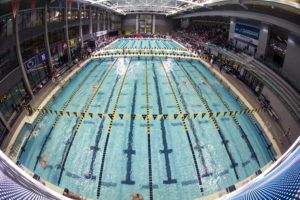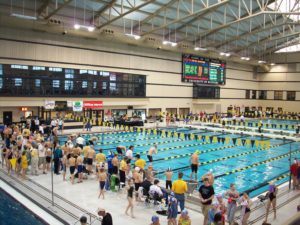Courtesy of Counsilman-Hunsaker, a SwimSwam partner.
For many swimmers, the months leading up to a championship competition are stressful. Tapering, travel, make-up assignments, proper nutrition, and getting much needed extra recovery between practices are just a few of the things that might burden a swimmer prior to a major championship event. It is important that a lackluster aquatic facility does not add to the stress or inhibit them from performing at their highest level.
Just as swimmers prepare themselves physically for competition, they prepare themselves mentally as well. Much of this preparation takes place in the weeks leading up to a championship. However, there can be circumstances that are impossible to anticipate, such as the facility environment, that can leave an athlete psychologically vulnerable before the start of a race. It is the job of facility designers to be considerate of athletes when designing a top rate natatorium. Fast swims signify a fast pool and in order for fast swims to occur, most swimmers want the “rock-star” experience.
Many teams travel together to and from championship meets using a private bus service, fleet of vans, or a car with chauffer (coach/loving parent). Swimmer drop off might be at the back entrance of the natatorium where the meet is being held. If they’re lucky, event staff might greet them with a high five and hold the door as swimmers are ushered off of the bus and into the facility. Chances are, they will have to walk through a long, barely lit, hallway to get to the locker rooms.
The locker room is an inevitable part of the swimmers natural progression to the blocks. Depending on the age groups participating, locker rooms can be difficult to make fool-proof. Given the opportunity, a group of 12 year-olds will make a slip and slide in the showers. Following warm up, swimmers journey to the locker room with a group of friends and change into their technical suits. This can take anywhere from a few minutes to half an hour deepening on how small the suit is. The atmosphere is charged. A great locker room should make athletes feel comfortable and efficiently move them in and out during this pre-meet surge. There is nothing worse than standing in line for one of three stalls with a 400 IM fast approaching.
The swimmers will emerge through a set of doors to the pool deck with music blaring and, ideally, hundreds of spectators waiting to watch some speed. As final preparations are made, swimmers will begin to shift into a racing mentality. Depending on the type of swim meet, some swimmers might wait have to wait hours to compete. Recognizing the proper amount of deck space required to keep entire teams of swimmers unencumbered during this waiting period is critical to the design process. Space is always a limiting factor, but the more seating and open areas provided that can help relieve any pre-tension, the better.
The scenario above only describes a swimmers entrance to a facility, however there is so much more that can affect a swimmers ability to race. Many swimmers follow pre-race routines that they have been doing for years. Some swimmers may become visibly energetic and vocal prior to stepping up on the blocks, while others take a more solitary and focused approach. Privacy may be an empty room, a corner under the stands, or simply a towel over the head. Regardless of how a swimmer prepares themselves individually, those good enough to advance to a finals heat will face another stage of preparation.
Contrary to the idea that athlete seating should relieve tension, the next step of the race progression should be designed around channeling energy. For high end competitions, a ready room must be provided. The location, design, and theme of this room can be a factor in motivating the swimmers. However, the most important factor is the time spent waiting in the room before the athletes are ceremoniously led out to their stations on deck. Facility designers might consider programming ideas for this room with meet officials or team representatives to ensure that not too much or too little time is spent waiting here. Everyone remembers the “face” made in the Rio 2016 ready room. A ready room creates an environment where a swimmer can ignite a passion within themselves moments before the start of a race. These internal factors affect the athlete prior to the race.

The seventh session of the 2015 Big Ten Men’s Swimming and Diving Championships Saturday, Feb. 28, 2015 at the Campus Recreation and Wellness Center on the University of Iowa campus in Iowa City, Iowa. (Brian Ray/hawkeyesports.com)
Finally, there are environmental factors created by the scale of the facility. Spectators become a part of the experience. Teammates and the pre-race and post-race ceremonies all demonstrate this. Again, think “rock-star”. The total pageantry of competitions, especially those at the highest levels, will have an impact on the athletes.
If all of the environmental cues and conditions come together, they help to produce record breaking times or personal best times for those that do not win. It can be a challenge to consider all of the users that will be fortunate enough to use an aquatic facility, but with careful planning and consideration, creating a great space is possible.
There are more factors that come into play when creating an optimal competition venue, however, those discussed here will almost always have a role. Additionally, these factors play a huge role in determining how swimmers and coaches will judge a natatorium and whether or not it is a “fast pool”.
About Us – Counsilman-Hunsaker
 The history of Counsilman-Hunsaker is valuable in the context and the confidence it provides. Over the past 45 years, we’ve led the industry by completing more than 1,000 national and international aquatic projects of every size and complexity. In fact, many of the innovations that are now standard in the industry were conceived by our team.
The history of Counsilman-Hunsaker is valuable in the context and the confidence it provides. Over the past 45 years, we’ve led the industry by completing more than 1,000 national and international aquatic projects of every size and complexity. In fact, many of the innovations that are now standard in the industry were conceived by our team.
Counsilman-Hunsaker believes that people of all ages are changed for the better through aquatic experiences and that our services reach beyond just solving design, or engineering or facility operational challenges. Our mission is to create aquatic experiences that transform people and communities, which supports our mantra of “Aquatics for Life”. And when we say “Aquatics for Life” we’re talking about the lives of humans we serve through every decision from conception, to the detail of daily operations. By focusing and serving the human experience, our full circle approach to everything we do allows us to be your guide every step of the way from facility audits, to program and design, thru facility creation and day to day operations.
Along the way, we’ve developed an international reputation for innovation and integrity, as people who are passionate about what they do and who do it exceptionally well. Today, our firm consists of an integrated team of designers, engineers and operational specialists with incomparable aquatic industry experience.
COUNSILMAN-HUNSAKER LINKS
SIGN UP FOR COUNSILMAN-HUNSKAER’S NEWSLETTER
CHECK OUT COUNSILMAN-HUNSAKER ONLINE: CHH2O.COM
LIKE US ON FACEBOOK
FOLLOW US ON TWITTER
CHECK OUT OUR AQUATIC INDUSTRY BLOG: HYDROLOGICBLOG.COM
WE DO MORE THAN COMPETITIVE POOLS: SEE OUR PAST PROJECTS HERE
Courtesy of Counsilman/Hunsaker & Associates, a SwimSwam ad partner.




I always disliked set-ups where, in the name of a compact footprint, spectator seating was on top of locker rooms and pool offices rather than going down to deck level. It seemed to disconnect them from what was going on in the water and make it impossible for a swimmer to have a word or two with someone in the stands on the way to the warm down area.
Liked the places that let you have access to the divers’ hot tub when you were finished with your meet.